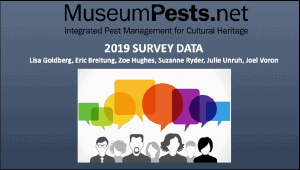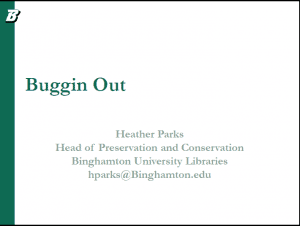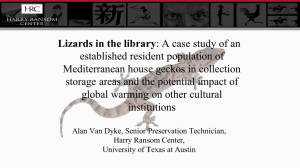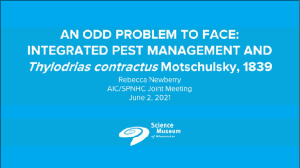AIC’s Collection Care Network presented a session of IPM papers at the Virtual Annual Meeting
Museum Pest Control: A Survey of Collections Care Trends
 Lisa Goldberg, Goldberg Preservation Services, LLC
Lisa Goldberg, Goldberg Preservation Services, LLC
Julie Unruh, Private Conservator, Houston
Joel Voron, Colonial Williamsburg Foundation
Suzanne Ryder, Natural History Museum, London
Eric Breitung, The Metropolitan Museum of Art
Zoe Hughes, Natural History Museum, London
The museumpests.net working group, formerly the Integrated Pest Management Working Group (IPM WG) conducted a survey in 2018 to gather information about current trends in resource allocation and operational practice in how collecting institutions monitor and eradicate pest incursions. The survey was constructed over the course of two working group meetings, as members grappled with how to ask questions that would allow respondents from institutions of all sizes to describe their collecting focus, budgets, staff allocations, preferred methods for pest treatments, and any observed changes in pest populations. Distributed worldwide, the survey collected data that was evaluated using SurveyMonkey’s innate analytics and Tableau, an open access data visualization program. Use of Tableau allowed us to pose different questions about the data by exposing relationships between various data sets, but also revealed flaws because of how we constructed the question set. This team will report on some general outlines for worldwide and regional trends in museum pest control methods, budgetary and personnel parameters, and pest populations. The museumpests.net working group is an unaffiliated group of museum and collections care professionals who collaborate remotely and gather once per year to provide updated information on their website. The site includes free and accessible key information about prevention, monitoring, identification, solutions, and resources about museum pests.
Buggin Out
 Heather Parks, Binghamton University, Binghamton
Heather Parks, Binghamton University, Binghamton
In 2019 Binghamton University initiated a Buggin Out IPM project with almost 8,500 traps being checked to determine our bug problems. We checked over 160 traps weekly throughout four buildings and used the ZPest Tracker to assist with interpreting the data. That data revealed book lice, carpet beetles and silverfish were a major issue in select areas. When we shut down in 2020, my hypothesis was that our bug number would grow due to limited human presence, darkness and traps that were left too long, encouraging predator insects. However, we ended up with 20% fewer bugs. It turns out the biggest player was mother nature in providing a drier year than 2019. I’ll use data to show the trends of infestation, the roles of humidity, predator insects and the changes in library use between 2019 and 2020 to explain our findings.
Lizards in the Library: A case study of an established resident population of Mediterranean house geckos in collections storage areas and the potential impact of global warming on other institutions
 Alan Van Dyke, Harry Ransom Center, The University of Texas at Austin, Austin
Alan Van Dyke, Harry Ransom Center, The University of Texas at Austin, Austin
An Odd Problem to Face: Integrated Pest Management and Thylodrias contractus (Odd Beetle)
Rebecca Newberry, Science Museum of Minnesota, St. Paul
 Thylodrias contractus, or odd beetle, is an unusual dermestid beetle. The males and females look strikingly different from each other and neither looks like any other dermestid. They do have the same tastes as dermestids, preferring the tasty proteins found in natural history collections. The females look like larva and cannot fly. They cannot easily move from place to place. They must be introduced. The best control method for odd beetles is prevention. Standard IPM procedures of inspection, isolation, preventive treatment, and monitoring should work.What happens, then, when a fairly robust IPM program fails to control odd beetles?The first confirmed odd beetle in the state of Minnesota was found in a display at the Science Museum of Minnesota (SMM) in the 1980’s. The infestation spread to a biology storage room, among other spaces. Regular IPM monitoring began in the early 1990’s and has continued to the present. When the museum moved to a new building in 1999, the conservation department used extensive IPM methods to prevent bringing odd beetles along.Unfortunately, there were a few hitchhikers. Every few months we find very small outbreaks of odd beetles during twice monthly IPM monitoring. They show up in unexpected places like offices and break rooms and have largely been excluded from collections due to rigorous isolation and low temperature treatments. It’s a frustrating experience since it’s been impossible to find an infestation source. We experimented with insect growth regulators and saw little change.I consulted with Tom Strang in 2014 and he suggested mapping the occurrences over time to predict where and when they might show up again. Using our IPM data, we mapped all odd beetle occurrences since 1999. The patterns which emerged from the mapping help us predict when we may see an outbreak. Then we use targeted pesticide applications along the wall baseboards. While the odd beetles have not yet been eradicated from the building, we are seeing encouraging reductions in their numbers.
Thylodrias contractus, or odd beetle, is an unusual dermestid beetle. The males and females look strikingly different from each other and neither looks like any other dermestid. They do have the same tastes as dermestids, preferring the tasty proteins found in natural history collections. The females look like larva and cannot fly. They cannot easily move from place to place. They must be introduced. The best control method for odd beetles is prevention. Standard IPM procedures of inspection, isolation, preventive treatment, and monitoring should work.What happens, then, when a fairly robust IPM program fails to control odd beetles?The first confirmed odd beetle in the state of Minnesota was found in a display at the Science Museum of Minnesota (SMM) in the 1980’s. The infestation spread to a biology storage room, among other spaces. Regular IPM monitoring began in the early 1990’s and has continued to the present. When the museum moved to a new building in 1999, the conservation department used extensive IPM methods to prevent bringing odd beetles along.Unfortunately, there were a few hitchhikers. Every few months we find very small outbreaks of odd beetles during twice monthly IPM monitoring. They show up in unexpected places like offices and break rooms and have largely been excluded from collections due to rigorous isolation and low temperature treatments. It’s a frustrating experience since it’s been impossible to find an infestation source. We experimented with insect growth regulators and saw little change.I consulted with Tom Strang in 2014 and he suggested mapping the occurrences over time to predict where and when they might show up again. Using our IPM data, we mapped all odd beetle occurrences since 1999. The patterns which emerged from the mapping help us predict when we may see an outbreak. Then we use targeted pesticide applications along the wall baseboards. While the odd beetles have not yet been eradicated from the building, we are seeing encouraging reductions in their numbers.